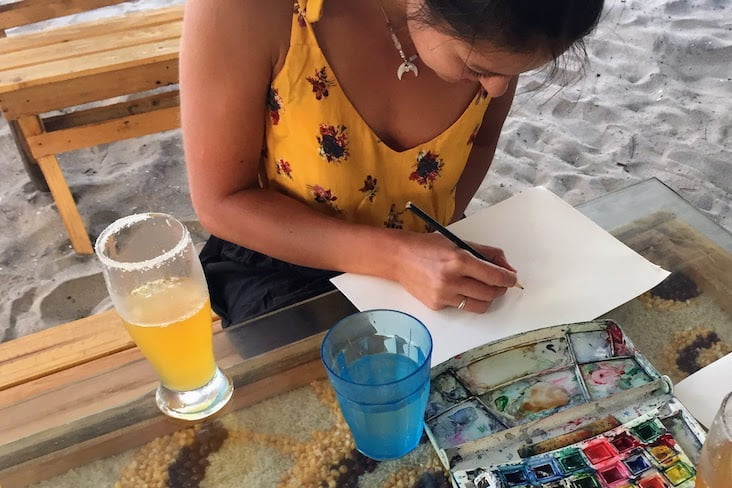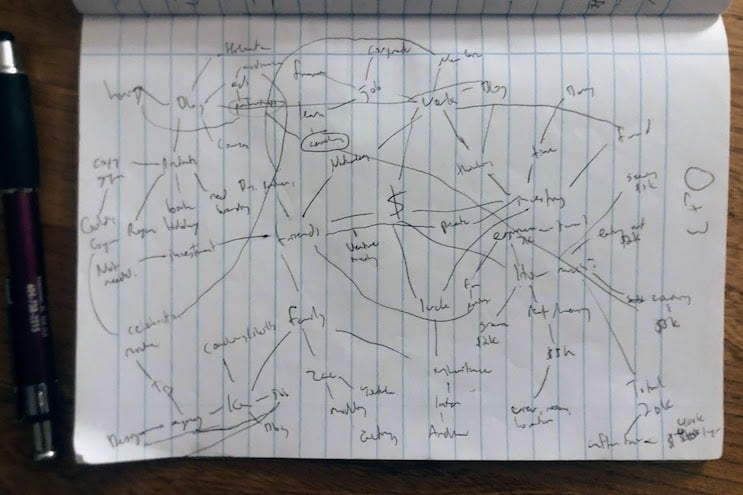If you’re stuck on a problem or trying to come up with creative ideas, you might want to try thinking differently. And I don’t mean “think outside the box.” I mean, try an actual different way of thinking.
For instance a series of studies led by Janet Geipel and Boaz Keysar found that listening speaks to our intuition while reading promotes analytic thought.
This got me wondering, what other ways of thinking might there be? And could they all use our brains differently?
Here are the eleven different ways of thinking I’ve come up with:
- 🤔 Reasoning
- 📚 Researching
- ✍️ Writing
- 🎨 Drawing
- 🕸 Mind Mapping
- 🗣 Talking
- 💤 Dreaming
- 🍄 Intoxicating
- 🤲 Outsourcing
- 🔨 Doing
- ⚪️ Nothing

1. 🤔 Reasoning
The classic way of thinking: silently constructing and arranging thoughts inside your brain.
You can reason by analogy.
For example, the different ways of thinking in this post are like military strategies you can use to attack the fortress of a difficult-to-crack problem. If one form of attack bounces off the walls, try another—or a combination. Persist long enough, and you’ll inevitably win the siege in a battle of attrition.
Or you can reason by first principles.
This involves breaking down your problem into its most basic components, assembling facts, and piecing together a solution. For examples, neuroscientists can study the brain to classify all the different ways it forms thoughts in our consciousness. They can then debunk and clean up this messy list of ways of thinking.
Tim Urban goes into elaborate and entertaining detail on these two ways of reasoning with an analogy of his own: The cook and the chef:
- A cook uses existing recipes (analogies).
- A chef starts with the raw ingredients (first principles) to create new dishes.

2. 📚 Researching
Consume information from various sources, such as books, articles, videos, lectures and podcasts.
You’re tapping into others’ thinking to use for your benefit.
Research also includes tapping into your own thinking from the past. This is why I’m a proponent of creating a “second brain” by taking notes on any ideas that may come in handy in the future.

3. ✍️ Writing
Writing takes your reasoning out of your head and puts the words in front of you. From this new perspective, you can:
- Identify inconsistencies, gaps, and weaknesses.
- Sort and arrange similar ideas.
- Combine different ideas into new ones.
If you write fast enough without letting reasoning interfere, you can sometimes tap into subconscious ideas.
Writing’s added bonus is that it relieves your conscious’ limited capacity, storing your thoughts externally for you to call up whenever necessary.

4. 🎨 Drawing
“Language can become a screen which stands between the thinker and reality. This is the reason why true creativity often starts where language ends.”
Arthur Koestler
Drawing helps you access deeper thoughts that may be difficult to express through words—especially if your vocabulary’s as bad as mine.
Edith Eger made me aware of this way of thinking in her book, The Choice. She writes about asking her psychotherapy patients to draw their family without using people, then deconstructing the output together.
Drawing is reasoning by analogy, but with the analogy coming before the reasoning.

5. 🕸 Mind Mapping
Mind mapping is playing connect-the-dots with your thoughts in a visual web of words.
Building on Tim Urban’s cook versus chef analogy I shared above, mind mapping is Iron Chef. It forces you to make something new out of ingredients you otherwise wouldn’t consider combining.
Try This Mind Mapping Technique
Here’s what Bill Burnett and Dave Evans outline in their book, Designing Your Life:
- At the center of a page, write the problem or topic you want to mind map.
- Around that, write the first five or six words related to it that come to mind.
- Around each of these five to six words, free associate three to four words. They needn’t have any association with the original word in the center.
- If you can, repeat for another layer.
- Circle the words on the outer edge of your mind map that most intrigue you.
- Try to connect those words to come up with novel approaches to your problem.
Set a time limit of a couple of minutes. That way, you bypass your inner censor.

6. 🗣 Talking
This is my wife Kim’s favorite way of thinking.
It used to annoy me when she’d blurt out some problem like, “I don’t know what to have for dinner,” or “Zac’s eczema’s getting really bad.” My mom’s words would echo in my mind: “Don’t give me more problems. Give me solutions.”
But now I understand.
Kim prefers to talk through her problems to find solutions. The improvisational nature of talking and the physical act of wagging your tongue deploy your brain differently. And, of course, it can help to reinforce your thinking with others’.
Talking to yourself works, too. I experience this when I dictate posts while walking. Semi-distracting my consciousness with changing surroundings and the responsibility of not losing my balance or walking into things helps, too.

7. 💤 Dreaming
Take Thomas Edison’s advice to “Never go to sleep without a request to your subconscious.”
Ironically, I remembered to add this is a way of thinking at 3 AM last night, when Zac’s screaming woke me up.

8. 🍄 Intoxicating
Mind-altering substances may not necessarily help you think better, but they will have you think in a different way.
You don’t have to consume a substance to think intoxicatedly, either. Falling in love, starving yourself, or whacking yourself hard enough on the head will do the trick, too.
Since I’m not a doctor and can’t lose my license, I recommend you try them all!

9. 🤲 Outsourcing
Let someone or something else do your thinking for you.
It could be your mom, your boss, or AI.

10. 🧗♀️ Doing
Overthinkers overlook this one.
My baby son Zac is the opposite. He just does stuff, Inner Game-style, without letting his consciousness get in the way.
Either extreme is unlikely the ideal approach to any problem, but I’d wager that something closer Zac’s approach is more productive. Certainly more exciting.
This brings to mind one of my favorite quotes, which I found in the Heath brothers’ book, Switch: How to Change Things When Change is Hard:
“It’s easier to act your way into a new way of thinking than think your way into a new way of acting.”
Jerry Sternin
When doing, you don’t get to pick what to think about, but it often leads to the best thoughts.
I think it’s because the external stimulation of your environment brings all sorts of novel inputs into your brain. And the internal stimulus of interacting with the environment seems to shake them up with others already inside. These inputs click together into creative thoughts.
11. ⚪️ Nothing
“[People of] genius sometimes accomplish most when they work the least.”
Leonardo Da Vinci
Do everything you can—or is it as little as you can?—to get out of your subconscious’ way. Wait for it to provide thoughts to you.
Think About It… in as Many Ways as You Can
For whatever problem you face, here’s my challenge to you:
Try combinations of all these ways of thinking to attack it from all angles.
If you know of any other ways to think, try those too. And share them with me in the comments, because I need help.
More On Using Your Brain Better
About the author
👋 I'm Chris. Everything you read on TheZag.com is my fault. This site is like a gym for your comfort zone, full of challenges to make your status quo sexier. Join my 'Consider This' newsletter for a fun new challenge every 10 days. Try it!



Leave a Comment